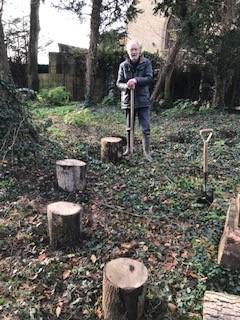
WHAT IS A WOOD?
There is very small woodland in Old Leake Common side which is one of two woodland of note in South Lincolnshire. Planted in the early 1900’s by a resident and then acquired by The Woodland Trust from whom Old Leake Parish Council holds a 25 year lease.
The intention was that we enrich this quarter of an acre historic woodland for the use of the residents and improve the biodiversity of the planet in a small way. This programme started during the middle of the last decade by clearing a large part of the undergrowth and removing fallen trees, which revealed an existing meandering pathway with little offshoots to the edges of the wood.
Since then work has gone on but in a way that this woodland remains very much as it was. It was never intended by Mr Eno to be a park or formal garden but just a pleasant place to wander and reflect. The hedging along the roadside boundary has been planted as a barrier to absorb the emissions from the many vehicles that use this road. It will also provide nesting for the birds.
The existence of a small pond was discovered – now full of leaf mould but under consideration for future reclaiming and further enhancing the surroundings.
The trees, now in full leaf, look rather fine allowing dappled sunlight to filter through and provide glimpses of butterflies, which include the Speckled Wood, potentially the Green Hairstreak and Red Admiral.
Beech trees are the prominent tree with their grey, smooth bark and were, in the past a fine canvas for the carving of graffiti, with love hearts and messages carved out during the World Wars. They are now starting to grow over and clearly not really to be encouraged. Yew and Hazel are also there with some smaller Hazels starting to grow and in seven years or so be ready for coppicing in a small way.
But the Elm, of course, is the significant, remaining tree – now under preservation order as the vast majority of Elms in the United Kingdom were sadly decimated during the 1970’s by Dutch Elm disease.
In the early months of the year snowdrops cover almost three quarters of the floor and there are small clumps of hellebores and daffodils. As spring progresses Bluebells can be seen (the indigenous English variety – not the Spanish). These are to be treasured and eventually other varieties of wildflower will emerge, including Wood Anenomies and Primroses, Red Campion and possibly Foxgloves – worth bearing in mind that Foxglove is a poisonous plant and to be steered clear of, pretty as they are.
We were, of course, hindered by Covid-19 but some work took place including a new fence erected at the rear. A small seating area of tree stumps for the children to visit with their teachers or parents to observe and learn about nature.
So this is a Wood!
A small oasis of hope in an area without many accessable woods nearby; full of potential for our children young and old and for generations to come, where the opportunity to spend a little time in these pleasant surroundings learning about the trees , the flora and fauna and how this fits in to benefit all of the community and the precious planet we were blessed to inherit.
We have done what we can so far but be in no doubt we will continue to caretake this small piece of England and where we can, given the opportunity from all aspects continue to preserve it to the best of our collective abilities for as long as we are able.
